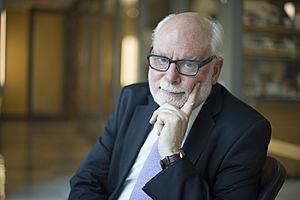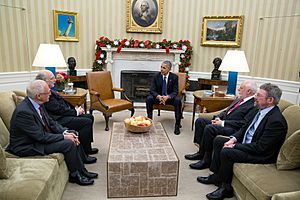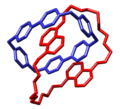Fraser Stoddart facts for kids
Quick facts for kids
Fraser Stoddart
FRS FRSE
|
|
|---|---|

Sir Fraser Stoddart in 2016
|
|
| Born |
James Fraser Stoddart
24 May 1942 Edinburgh, Scotland
|
| Died | 30 December 2024 (aged 82) Australia
|
| Citizenship | United Kingdom United States |
| Alma mater | University of Edinburgh (BSc, PhD) |
| Known for | Mechanical Bond in Chemistry Molecular shuttles and Molecular switches Artificial Molecular Machines Template-Directed Synthesis Chemical Topology Stereochemistry Metal-Organic Frameworks Cyclodextrin Chemistry |
| Spouse(s) |
Norma Agnes Scholan
(m. 1968; |
| Children | Two Fiona Jane McCubbin Alison Margaret Stoddart |
| Awards |
|
| Scientific career | |
| Fields | Physical Organic Chemistry Lock-and-Key Chemistry Unnatural Product Synthesis Molecular Nanotechnology |
| Institutions | Queen's University (1967–1969) University of Sheffield (1970–1990) ICI Corporate Laboratory, Runcorn (1978–1981) University of Birmingham (1990–1997) University of California, Los Angeles (1997–2007) Northwestern University (2008– ) Tianjin University (2014– ) University of New South Wales (2018– ) University of Hong Kong (2023– ) |
| Theses |
|
| Doctoral advisor |
|
| Other academic advisors |
|
| Notable students | David Leigh Narayanaswamy Jayaraman Douglas Philp |
Sir James Fraser Stoddart (born May 24, 1942 – died December 30, 2024) was a famous British-American chemist. He was a professor at the University of Hong Kong and Northwestern University. Sir Fraser was a leader in an area of chemistry called supramolecular chemistry. This field focuses on how molecules can connect and work together.
He also worked in nanotechnology, which is about building tiny machines and devices at the atomic or molecular level. Sir Fraser was known for creating special types of molecules that are linked together like chains or rings. These are called molecular Borromean rings, catenanes, and rotaxanes. He showed that these tiny structures could act like molecular switches. His work helped create very small electronic devices and machines. In 2016, he won the Nobel Prize in Chemistry along with Ben Feringa and Jean-Pierre Sauvage. They were recognized for designing and building these amazing molecular machines.
Contents
Early Life and School
Fraser Stoddart was born in Edinburgh, Scotland, on May 24, 1942. He grew up on a farm called Edgelaw Farm. As a child, he loved jigsaw puzzles and building toys. He believed this early interest helped him become interested in building molecules later on.
He went to school in his village and then to Melville College in Edinburgh. In 1960, he started studying chemistry, physics, and math at the University of Edinburgh. He earned his first degree in Chemistry in 1964. Then, in 1966, he received his PhD for his research on natural gums found in Acacia trees.
A Career in Chemistry
After finishing his studies, Stoddart moved to Canada in 1967 for a research position at Queen's University. In 1970, he joined the University of Sheffield in England as a chemistry lecturer.
In 1978, he spent some time at the University of California, Los Angeles (UCLA). Later that year, he moved to the ICI Corporate Laboratory in England. This is where he began his important work on molecules that are linked together, which later became known as molecular machines. He returned to Sheffield in 1982.
In 1990, he became a professor at the University of Birmingham. He also led the School of Chemistry there from 1993 to 1997. In 1997, he moved back to UCLA as a chemistry professor.
From 2003 to 2007, he directed the California NanoSystems Institute (CNSI). In 2008, Stoddart joined Northwestern University in the United States. There, he started his own research group, the Mechanostereochemistry Group. He also directed the Center for the Chemistry of Integrated Systems (CCIS) at Northwestern.
Later in his career, he took on part-time positions at the University of New South Wales in Australia (2017) and the University of Hong Kong (2023). Over 35 years, nearly 300 PhD students and researchers learned from him in his labs.
Amazing Molecular Machines
Sir Fraser Stoddart is one of the few chemists who started a completely new area in organic chemistry. He focused on molecules that are connected by "mechanical bonds." These are not like normal chemical bonds. Instead, the molecules are linked together like rings on a chain, but they can still move around each other.
His work led to new ways of building molecular machines. These tiny machines can be controlled to move or switch between different states. They have potential uses in molecular sensors, actuators (devices that move things), and amplifiers. They can be controlled by chemicals, electricity, or light.
One of his biggest achievements was finding easy ways to create rotaxanes and catenanes. These are molecules that are mechanically interlocked. He also created complex structures called molecular Borromean rings. These are three rings linked in a way that if you break one, all three fall apart.
Stoddart showed that these tiny devices could be made using two main approaches:
- Bottom-up approach: This is like building with LEGOs, where molecules naturally connect themselves in the right way.
- Top-down approach: This is like carving a sculpture, where larger materials are shaped into tiny devices using tools like lithography.
His work helped bridge the gap between chemistry and the challenges of building very small mechanical systems. As another scientist, David Leigh, said, Sir Fraser Stoddart had the vision to see that these linked molecules could be the basis for molecular machines.
How He Showed His Work
Stoddart's scientific papers and presentations are easy to spot because of his unique "cartoon" style. He used simple drawings and bright colors to show his molecules. For example, he often put a solid circle in the middle of aromatic rings. He used different colors to highlight different parts of the molecules. Blue often showed parts that accept electrons, and red showed parts that donate electrons. This clear style helped other scientists understand his complex ideas.
Personal Life
Sir Fraser Stoddart was a citizen of both the United States and the United Kingdom. He was married to Norma Agnes Scholan from 1968 until she passed away in 2004. Norma had a PhD in biochemistry and supported her husband's research.
Sir Fraser Stoddart died on December 30, 2024, at the age of 82, while on holiday in Australia.
Awards and Honors
Sir Fraser Stoddart received many important awards for his groundbreaking work:
- In 2006, he was made a Knight Bachelor by Queen Elizabeth II for his contributions to chemistry and nanotechnology. This means he was given the title "Sir."
- In 2007, he received the Albert Einstein World Award of Science. This award recognized his amazing work in understanding how molecules recognize each other and how he found quick ways to build mechanically linked molecules.
- In 2016, he shared the Nobel Prize in Chemistry for his work on designing and creating molecular machines.
Images for kids
See also
 In Spanish: Fraser Stoddart para niños
In Spanish: Fraser Stoddart para niños





